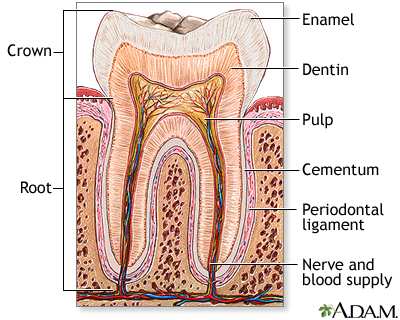Gum biopsy
Definition
A gum biopsy is a surgery in which a small piece of gingival (gum) tissue is removed and examined.
Alternative Names
Biopsy - gingiva (gums)
How the Test is Performed
A painkiller is sprayed into the mouth in the area of the abnormal gum tissue. You may also have an injection of numbing medicine. A small piece of gum tissue is removed and checked for problems in the lab. Sometimes stitches are used to close the opening created for the biopsy.
How to Prepare for the Test
You may be told not to eat for a few hours before the biopsy.
How the Test will Feel
The painkiller put in your mouth should numb the area during the procedure. You may feel some tugging or pressure. If there is bleeding, the blood vessels may be sealed off with an electric current or laser. This is called electrocauterization. After the numbness wears off, the area may be sore for a few days.
Why the Test is Performed
This test is done to look for the cause of abnormal gum tissue.
Normal Results
This test is only done when gum tissue looks abnormal.
What Abnormal Results Mean
Abnormal results may indicate:
- Amyloid
- Noncancerous mouth sores (the specific cause can be determined in many cases)
- Oral cancer (for example, squamous cell carcinoma)
Risks
Risks for this procedure include:
- Bleeding from the biopsy site
- Infection of the gums
- Soreness
Considerations
Avoid brushing the area where the biopsy was performed for 1 week. You may be given a mouthwash to keep the area clean for a week after the procedure.
Gallery


References
Ellis E, Huber MA. Principles of differential diagnosis and biopsy. In: Hupp JR, Ellis E, Tucker MR, eds. Contemporary Oral and Maxillofacial Surgery. 7th ed. Philadelphia, PA: Elsevier; 2019:chap 22.
Wein RO, Weber RS. Malignant neoplasms of the oral cavity. In: Flint PW, Francis HW, Haughey BH, et al, eds. Cummings Otolaryngology: Head and Neck Surgery. 7th ed. Philadelphia, PA: Elsevier; 2021:chap 91.
